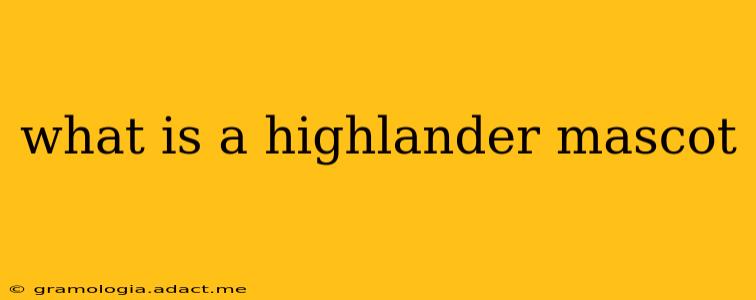The term "Highlander" mascot evokes images of strength, resilience, and a connection to a rich history. But what exactly is a Highlander mascot, and why is it chosen so frequently as a symbol for schools and teams? This comprehensive guide will explore the various interpretations and representations of the Highlander mascot, addressing common questions and delving into the reasons behind its enduring popularity.
What Makes a Highlander Mascot?
A Highlander mascot typically represents a warrior or fighter from the Scottish Highlands. This imagery draws on a powerful cultural heritage, incorporating elements like kilts, sporrans, swords, and bagpipes. However, the specific depiction can vary significantly depending on the institution or team using the mascot. Some might portray a fierce warrior ready for battle, while others opt for a more friendly and approachable character. The key elements that generally define a Highlander mascot are:
- Scottish Heritage: The clear link to Scottish culture and history is paramount.
- Strength and Courage: The mascot embodies qualities associated with Highland warriors.
- Pride and Tradition: The Highlander often represents a sense of heritage and belonging.
- Visual Representation: This can range from a fierce, anthropomorphic warrior to a more stylized, symbolic representation.
What are some common visual representations of a Highlander Mascot?
Several factors influence the visual design of a Highlander mascot:
- Anthropomorphic: Many mascots are human-like figures, often wearing traditional Highland attire (kilts, sporrans, etc.) and wielding weapons such as swords or claymores.
- Animalistic: Some institutions may incorporate elements of animals associated with Scotland, such as a stag or a ram, into their mascot design.
- Abstract/Symbolic: Certain designs might focus on more abstract representations of Highland culture, such as a stylized mountain peak or a clan crest.
- Modern vs Traditional: Mascots can range from a traditional, historically accurate representation to a more modern, stylized version.
Why are Highlander mascots so popular?
The enduring popularity of the Highlander mascot stems from several factors:
- Strong Symbolism: The imagery resonates with ideas of strength, resilience, and perseverance – attributes many institutions seek to embody.
- Cultural Significance: Scottish culture is rich and appealing, lending an air of prestige and tradition to the mascot.
- Uniqueness: In comparison to more common animal mascots, the Highlander offers a unique and memorable identity.
- Versatility: The design can be adapted to fit various styles and interpretations, allowing for creative freedom.
What are some famous examples of Highlander mascots?
Numerous schools and sports teams across the globe utilize the Highlander as their mascot. While specific visual representations vary, the underlying themes of strength, heritage, and tradition remain constant. Searching online for "[Institution Name] Highlander mascot" will reveal specific examples.
What is the difference between a Highlander and other similar mascots, like a Warrior?
While both Highlander and Warrior mascots represent strength and courage, the Highlander specifically connects to Scottish heritage. A generic "Warrior" mascot might draw inspiration from various cultures and time periods, lacking the specific cultural ties to Scotland that define a Highlander.
How are Highlander mascots used in marketing and branding?
Highlander mascots are powerful branding tools. They are frequently incorporated into logos, merchandise, and promotional materials, helping to build institutional identity and school spirit. The strong imagery readily lends itself to various marketing strategies, enhancing brand recognition and appeal.
This exploration of the Highlander mascot delves beyond a simple definition, illuminating the rich symbolism, cultural connections, and diverse visual interpretations associated with this popular mascot choice. Its enduring appeal speaks to the powerful combination of strength, heritage, and visual impact it represents.
